Having spent a great night sleeping peacefully and long, aware that my lost luggage would be delivered to the hotel the following day, I woke up a little earlier in order to have breakfast on time since already at 8.30 I had a meeting with Joao.
I have already mentioned that this was a guy from Madeira whom I found through a couch-surfing site, but I contacted him only with an idea to possibly meet and have a coffee together. However, he proposed that we go together on an excursion by his car. Moreover, as I mentioned to him the day before when we spoke on the phone that my luggage had not arrived, he immediately proposed that he came to pick me up in the morning and then we could go to the airport to look for my luggage or at least the information about it. But, since I had been informed meanwhile that my bag had been located there was no need for something like that.
I must admit that I was in two minds whether this was smart on my part. I did not know Joao and even less I knew how he drove and so I wondered if I had made a mistake by accepting that we went on an excursion right away. As I was packing a few things in my small backpack that I wanted to take with me, the phone rang and the people from the reception informed me that “Mr. Joao such-and-such” was waiting for me at the reception. It occurred to me that nowadays only the gentlemen of the “old school” did something like that and in this world of superficiality and not paying attention to anything this has become a true rarity and consequently a very valuable thing.
On the other hand, I am old and experienced enough to know that contrary to many current theories in the field of psychology my first impression about people means absolutely nothing. That is why I pay no attention to my first impression and wait to see what the second one is going to be like. For the record, at first sight Joao seemed very nice and he was all smiles. As soon as we met formally, he said we would first go to a place called Câmara De Lobos in order for me to try a Madeira specialty there – the poncha. This is a strong alcoholic drink. I was additionally worried about this for a couple of reasons. First, it was around 8.30 in the morning! I don’t drink alcohol that early in the morning: not even some weak version, let alone a strong one. Second, I wondered how Joao would drive after such a drink – I NEVER enter a car with people who have just drunk. But, I was a happy woman, I had information that my bag had arrived at the airport and then I said to myself I should relax – after all I could stop our association at any point if something did not suit me. And so Joao and I went to his car and started with the drive exchanging just some general comments along the way.
Câmara De Lobos practically extends westwards from Funchal and the two of us descended by car to the port in this place that was but some 10 km away from my hotel.
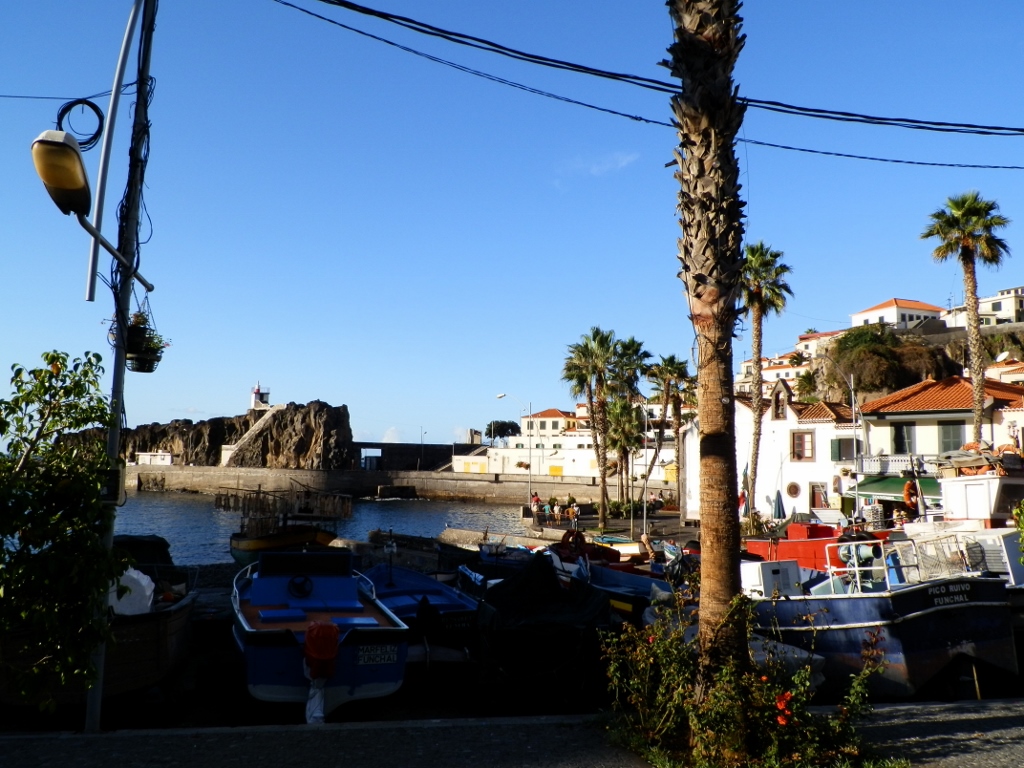 Câmara De Lobos
Câmara De Lobos
It was Sunday, earlier in the morning, but there were already quite a few people in the centre. Joao took me to one bar in which the original poncha is made, while on a tiny square in front of the bar there were a lot of people sitting at some seemingly improvised tables, having fun and playing cards. There were also a lot of clients in the bar and it was only just past 9 am.
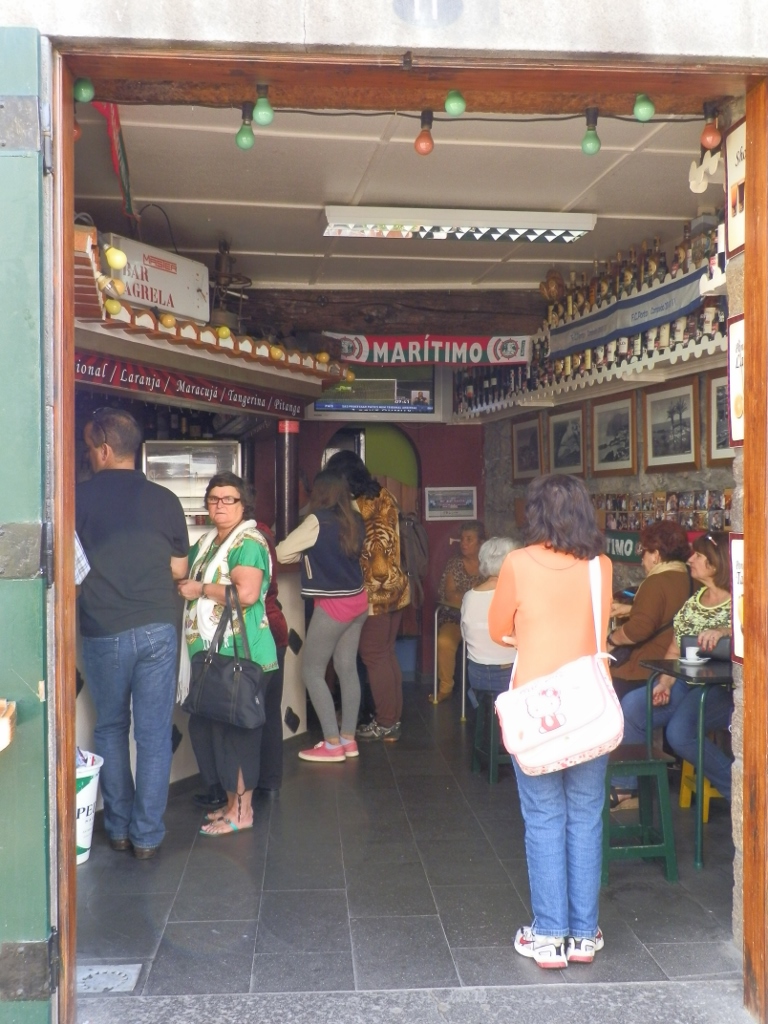 Bar in the port of Câmara De Lobos
Bar in the port of Câmara De Lobos
The poncha is a traditional drink on Madeira and together with the wine named after this island (a little more about it later on), it is the most popular alcoholic drink here. It is made of lemon, honey or sugar and aguardente – strong spirit obtained from sugar cane. By the way, the name of this alcoholic ingredient is a compound noun in the Iberian languages, e.g., in Spanish (aguardiente) and in Portuguese (aguardente), and it means burning/fiery water. Just to make it clear what spirit I’m talking about here.
Although nowadays it is the ready-to-use lemon juice that is used for tourists, Joao brought me to this bar where everything was done by the book. First the bartender finely pealed the lemon rind (the yellow part), putting this into a tall glass, pealing and discarding the white part of the rind (as it is bitter), adding sugar into the glass and a few lemon wedges, and then he started to pound the lemon and the sugar in the glass using a wooden pestle. Afterwards he added some more lemon and when he was content with the battered mixture in the glass, he poured in aguardente, a spirit made of sugar cane which in this case had 50% alcohol and then he mixed it all together using a special wooden tool called the mexelote. It is like the precursor of the immersion blender. Afterwards, the liquid is strained into a small glass and the drink is ready.
This is what it looked like:
It is interesting that on Madeira it is said that poncha cures cold and people who have flu symptoms here are encouraged to drink poncha. Perhaps this is actually not too weird, for it is said that the poncha was in fact invented back in the 16th century because it had been established that during their voyages the seafarers got scurvy on account of the long-term lack of vitamin C. In order to preserve lemon during those long voyages, the seafarers immersed lemon which is full of vitamin C into the alcohol beverage and molasses made of sugar cane in order to make it last longer during the journeys. As Madeira is in the Atlantic Ocean, i.e., it is a suitable stop on the way to distant destinations, while lemon and sugar cane grow here in abundance, this was a great place for the seafarers to get their supplies of the “medicines” here. Likewise, while I was waiting for the drink, I thought: “If it’s good for health, it’s fine!” Even if this concerns a strong alcoholic drink at around 9.30 in the morning. Cheers!
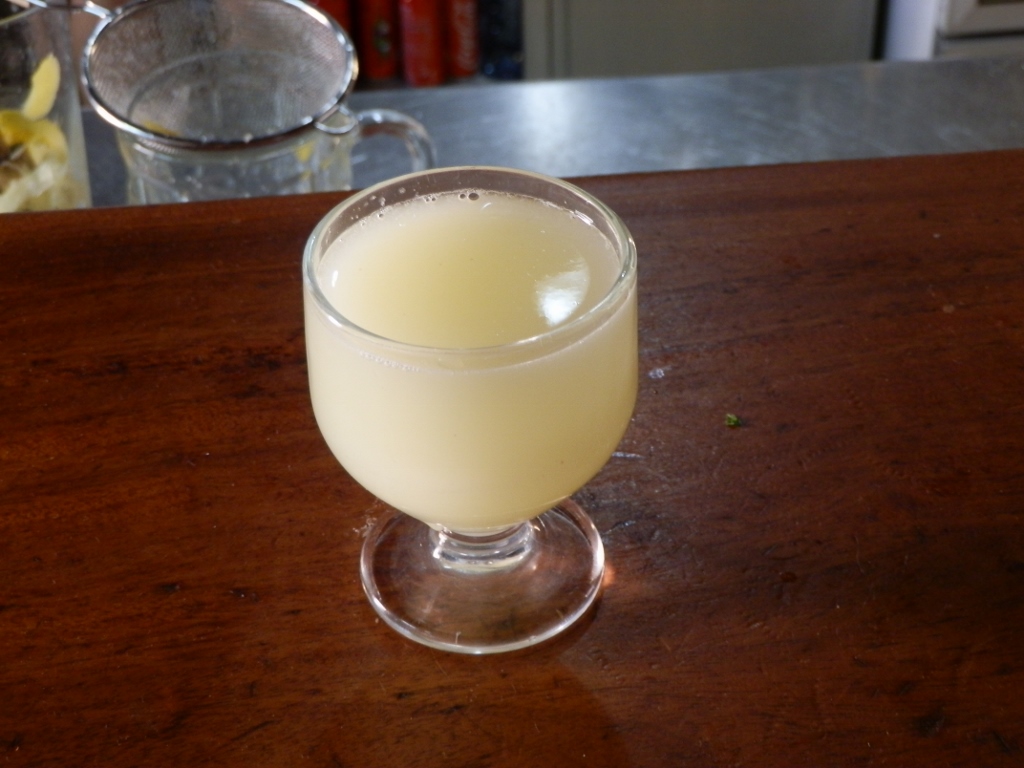 Poncha
Poncha
On the other hand, this was an inspirational experience, for a couple of days later, as an original souvenir from Madeira, I bought a mexelote for myself. It’s not that I use it often, but it is certainly a nice reminder of a fine early Sunday morning on Madeira.
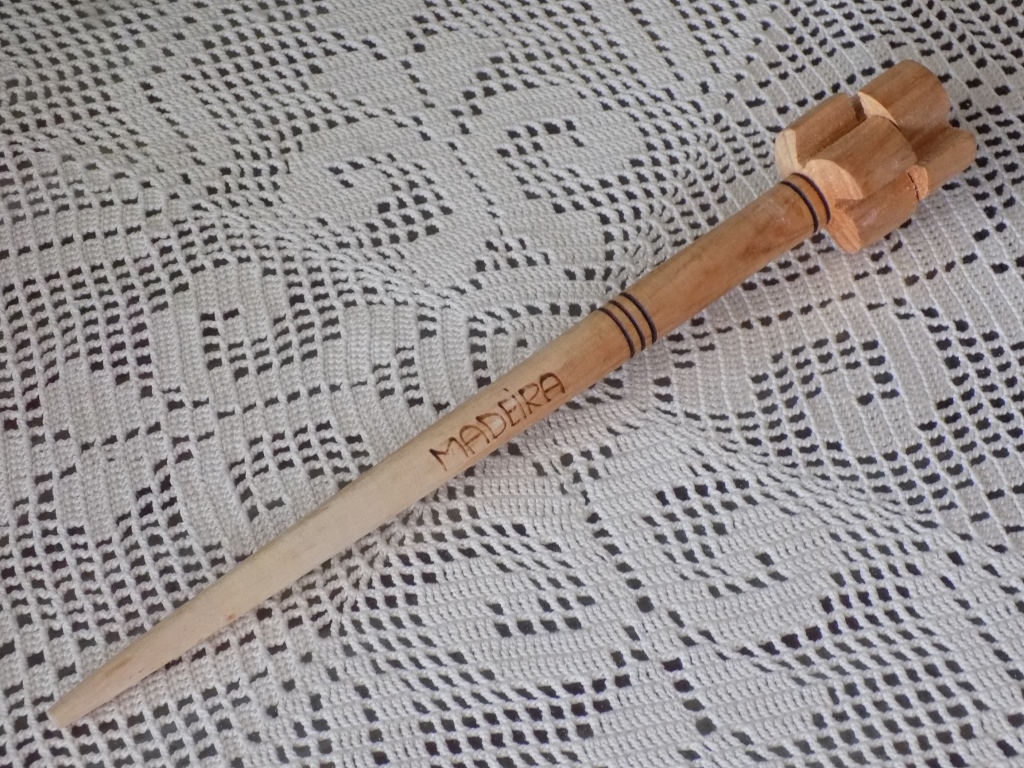 Mexelote at my home
Mexelote at my home
By the way, as it may be seen in the video above, as well as on the photograph, the bartender prepared only one glass of poncha and it was for me. I did ask Joao if he was going to take one, but he simply said he would not, since he was driving. In other words, I could be completely at ease as far as driving was concerned and anyway by the time we reached Câmara De Lobos it was clear to me that Joao was a very good and safe driver, so I no longer worried about this at all.
Together with poncha, I was given something to nibble and I think these were small pieces of fish that Joao mentioned, which they called gata, meaning “cat.” Trying to find the proper name in English for this fish I came across two terms: dogfish and cat shark.
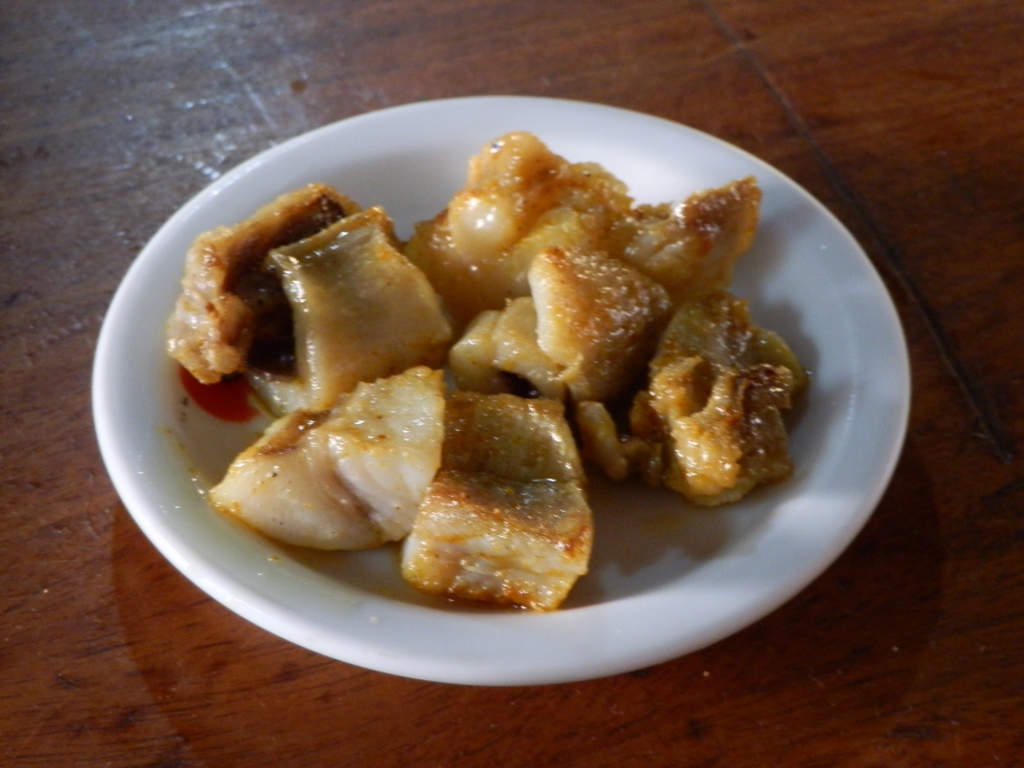 Fish to go with the poncha
Fish to go with the poncha
What was very good about this fish was that it was quite salty. I think that this increased quantity of salt helped neutralise faster the alcohol from the poncha that was in my body. What I want to say was that I was not tipsy, so Joao and I headed back for the parking lot and the car.
Still, we first went to the shore in order for me to see better the locally popular fish that was arranged on a boat to dry in the sun. The port of Câmara De Lobos is famous for this fish that is sundried here, as if it were an exhibition.
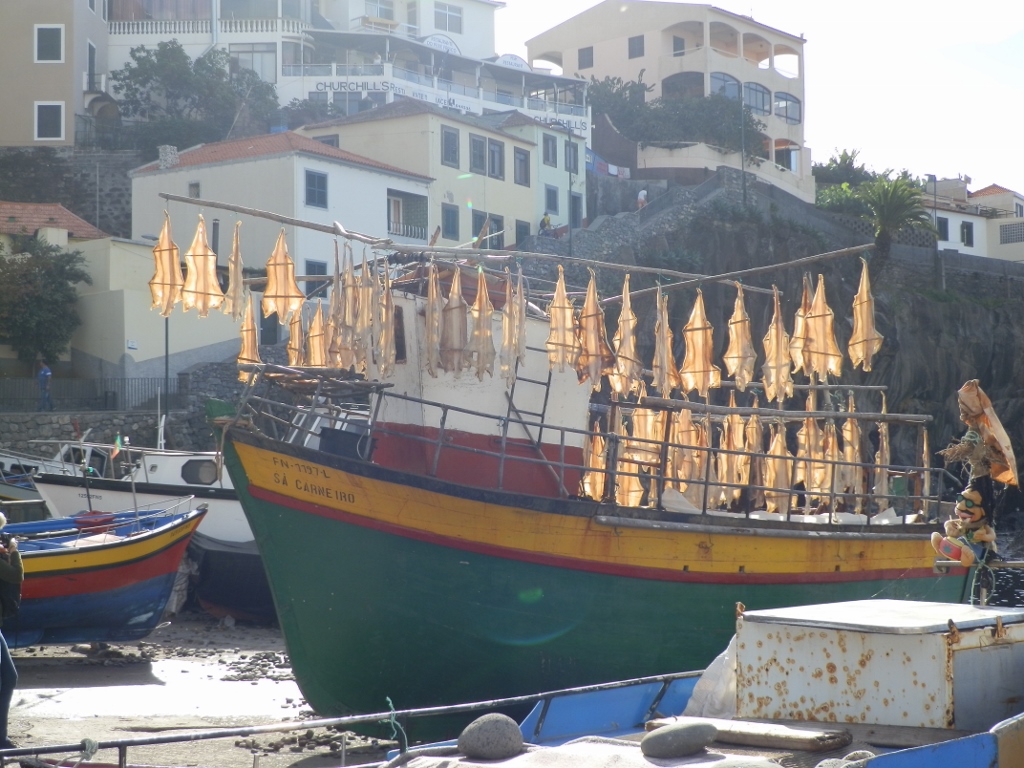 Fish gata is being sundried
Fish gata is being sundried
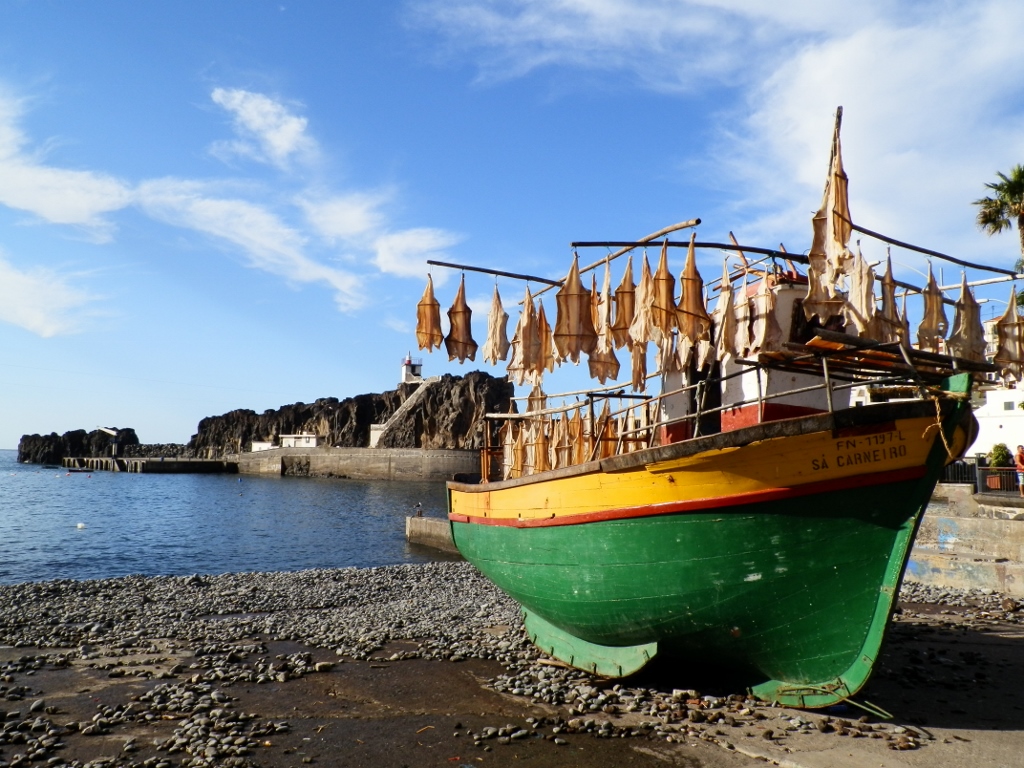 Fish gata is being sundried
Fish gata is being sundried
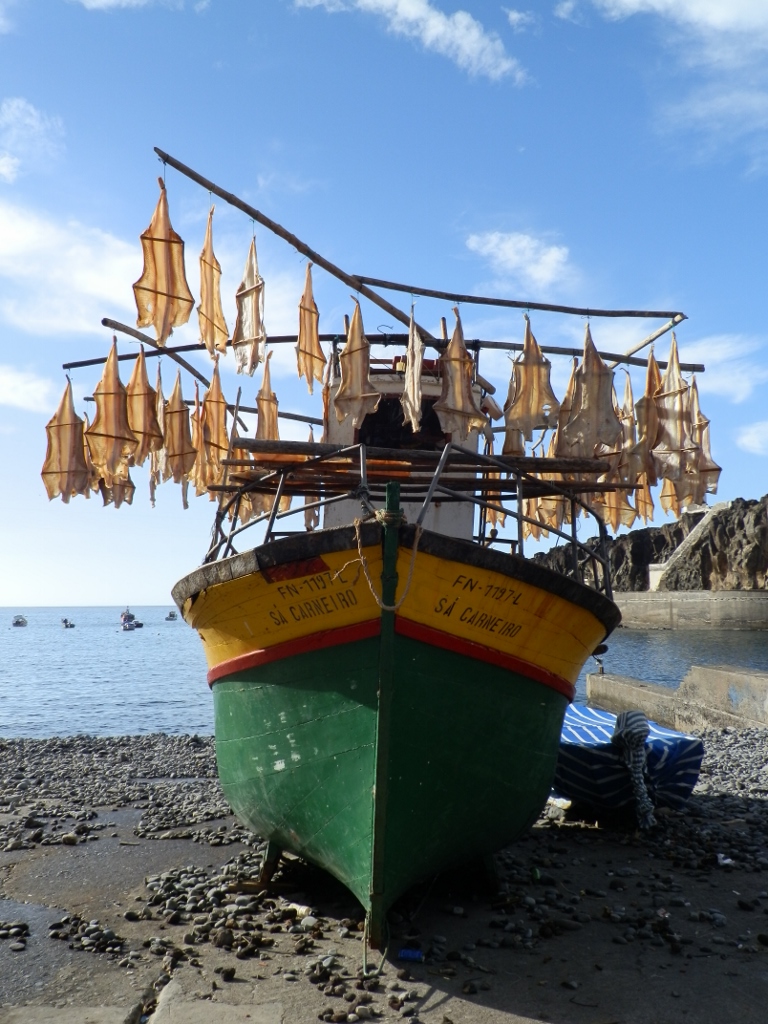 Fish gata is being sundried
Fish gata is being sundried
But, Câmara De Lobos need not be visited only in order to take the poncha or to eat the fish. It is also possible to merely enjoy the sights while sitting in a café.
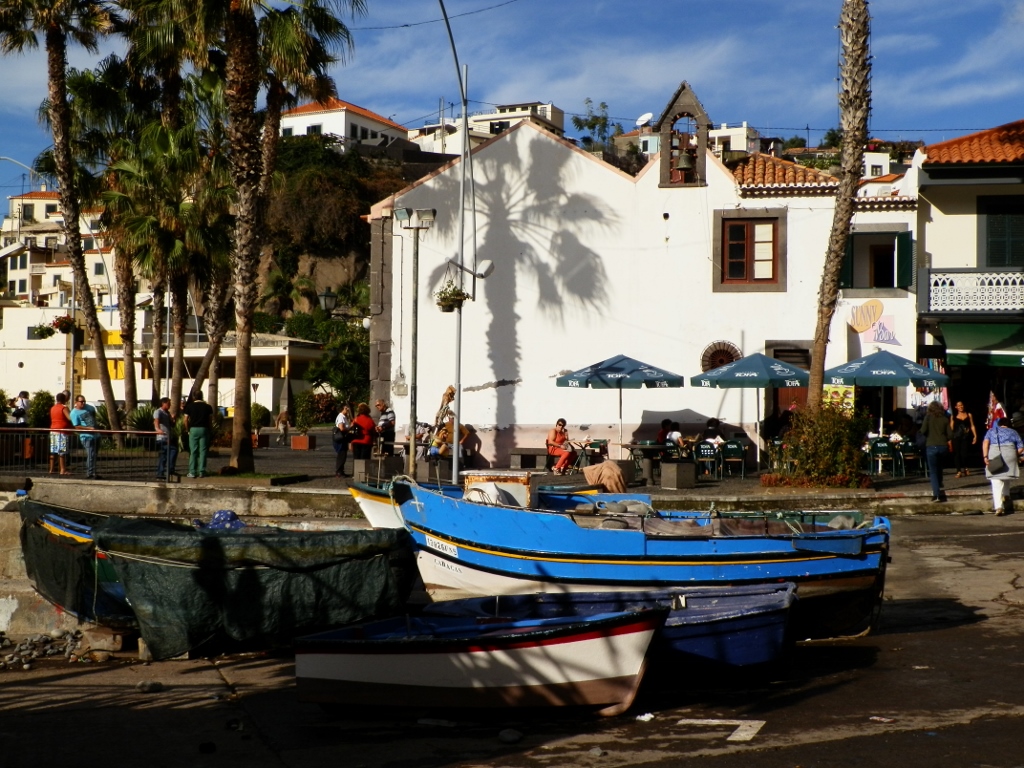 Detail from the port of Câmara De Lobos
Detail from the port of Câmara De Lobos
While we were walking along a street I was completely impressed when high above the place I saw steep slopes of the hills on which there were nicely arranged agricultural terraces with a lot of bananas growing on them.
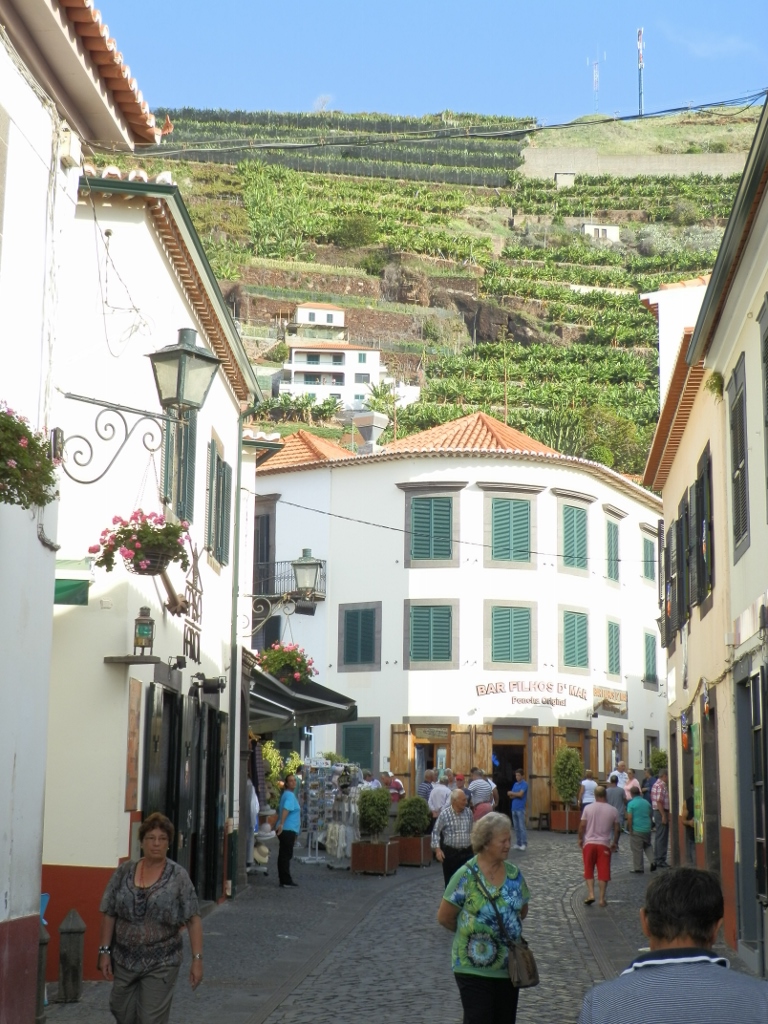 Gardens above the port of Câmara De Lobos
Gardens above the port of Câmara De Lobos
Generally speaking, thanks to the beautiful climate that predominates on Madeira, all sorts of fruits may be grown here, but I also presume that there is a tradition for ships coming from Brazil, former Portuguese colony, to unload goods here before getting to the continental part of the country. In those terms, Madeira is very suitably positioned.
After this Joao and I went uphill to the place called Estreito de Câmara de Lobos, which is in fact a parish within the municipality of Câmara De Lobos. Joao told me that there was a very good place to eat some grilled meat, but of course it was far too early and I had already had my breakfast, plus I also ate the fish at the bar. On the other hand, it was problematic to park the car in the very centre, so Joao just let me get out of the car in order to take photos, while he went to make a circle by car.
In the place where he left me, there is a fine expanse and also the Church of Our Lady of Grace (Igreja de Nossa Senhora da Graça) from 1814.
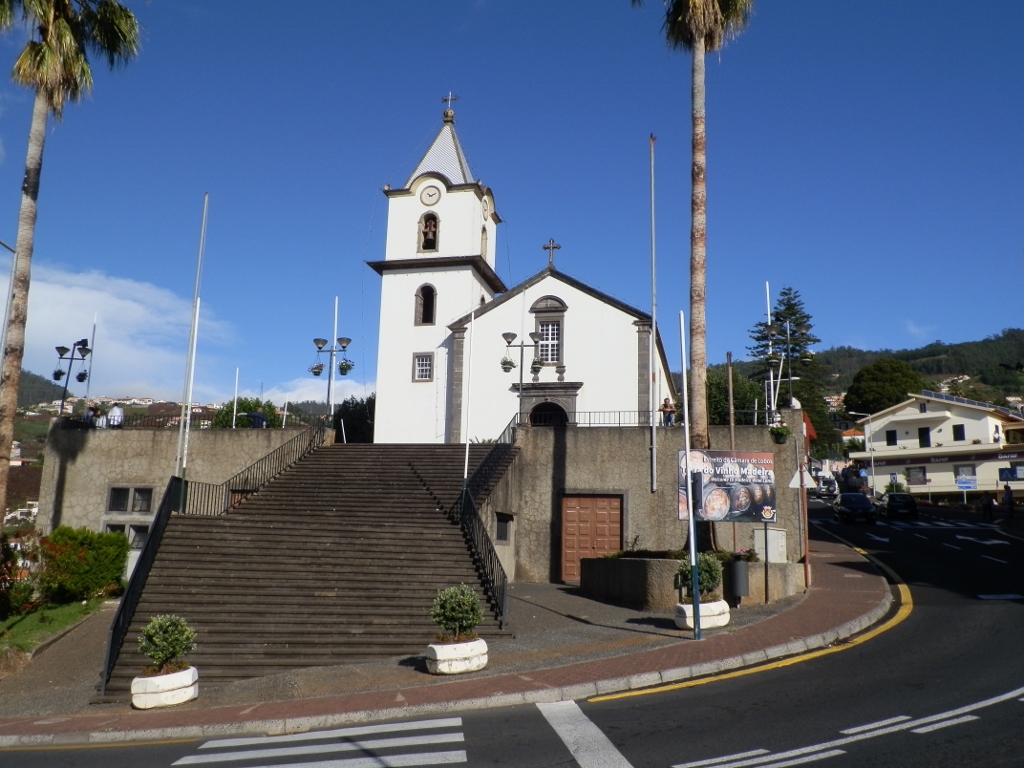 Church of Our Lady of Grace
Church of Our Lady of Grace
But, the whole place is much better known by being the centre for the production of the famous Madeira wine and they like to point this out like, for instance, on the billboard seen in the following photo.
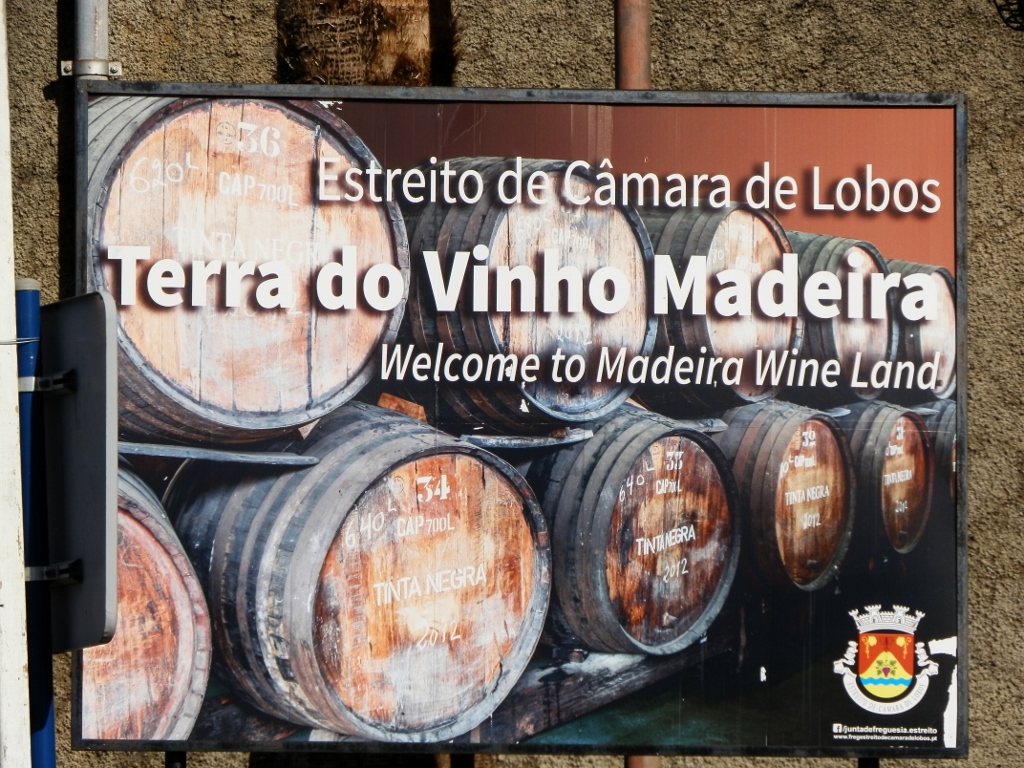 Estreito de Câmara de Lobos – the wine land
Estreito de Câmara de Lobos – the wine land
And it is not that they boast about it in vain, for all around it was possible to see densely planted vineyards, again arranged on agricultural terraces, since this is in the middle of the hilly and mountainous area.
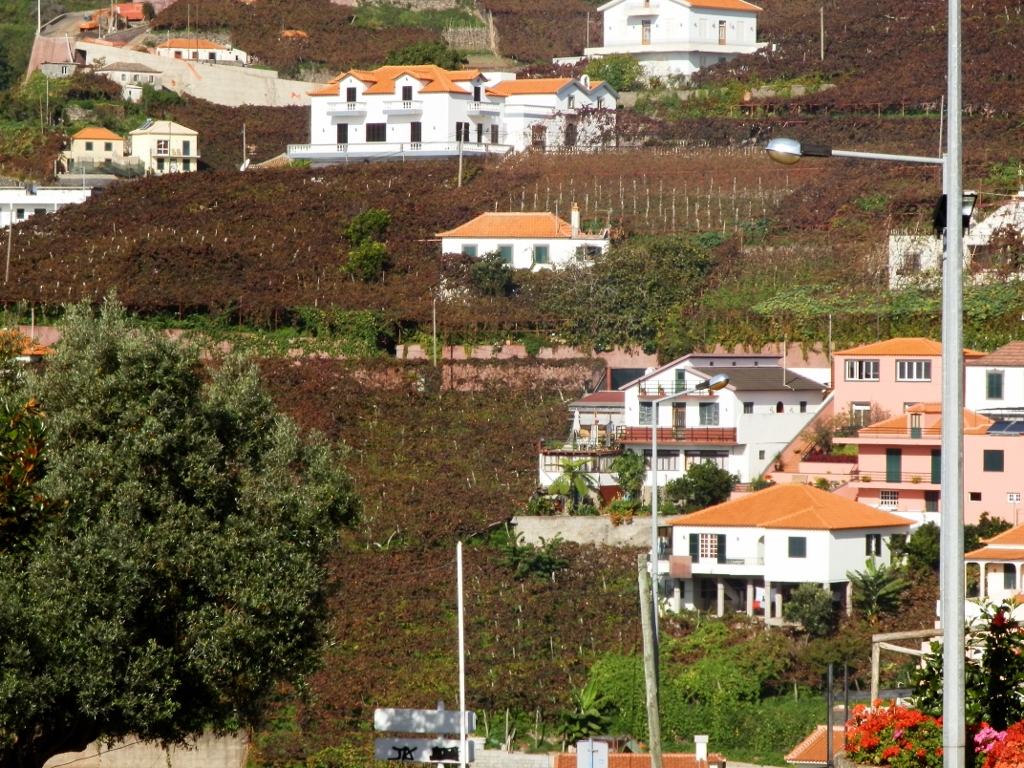 Vineyards in Estreito de Câmara de Lobos
Vineyards in Estreito de Câmara de Lobos
As the historic data say, from the middle of the 16th century the ships that stopped at Madeira also took supplies of the local wine since it contained large quantities of vitamins and minerals, thus helping the sailors to avoid scurvy. Well, people will come up with all sorts of things in order to justify binge-drinking! The, poncha – ok, at least it has a lot of lemon, but wine against scurvy? But then again, there’s an excuse for everything.
On the other hand, what is much more important is that during these “medical treatments” it was noticed that the wine was tastier after the barrels had been exposed to the tropical sun for a longer period of time. All in all, already back in the 18th century they found more efficient ways to warm up the wine during the production rather than taking it on a grand world tour. Even today, the technology entails the heating up of the wine to a certain temperature over the period of six months before the final steps in the production.
The Madeira wine is exceptionally tasty and pleasant to drink (at least for me) and there are four main varieties: Bual, Malmsey, Sercial and Verdelho. Although all four types have an amber-like colour they are made of white grapes and among other things it is important at which altitude those grapes grow. The best know variety of the Madeira wine is Malmsey which is made of malvasia grapes.
Just as I had taken the photos at this place, looking around a little, Joao came back to pick me up.
We continued with our drive and then we came to a wonderful viewpoint. The weather was perfect and in addition to the port of Câmara De Lobos from that height it was also possible to see well the terraced agricultural plots with different crops. My impression was that wherever there was any piece of land people used it to grow something. This was all obviously developed by hard-working and entrepreneurial people.
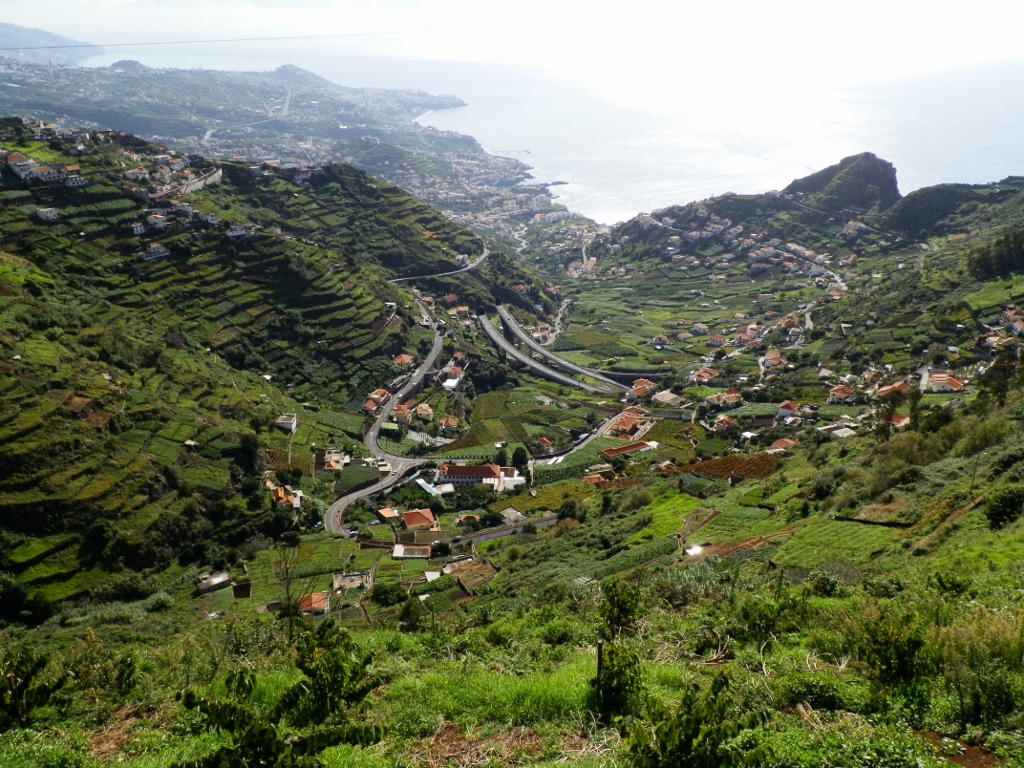 View at the south parts of Madeira
View at the south parts of Madeira
In the photo above, it is possible to see two segments of the motorway, called the fast road here, but for me it was definitely much more interesting to drive on the different smaller roads picked by Joao.
It was Sunday and Joao had set aside the whole day to spend it with me and to take me around Madeira. As we started to speak more, I told him I wanted to rent a car for three days in order to visit some other parts of the island. However, since Joao was in-between jobs and thus had a lot of free time, he said right away that there was no need for me to rent a car, since he had a car and we could drive around the island in his car. I was really very pleasantly surprised by such a generous offer. But, what was much more important was that in the meantime it had become quite clear to me that Joao was one fantastic human being! An exceptionally dear person, pleasant to spend the time with, very well educated with a broad spectrum of interests and it also turned out we had the same sense of humour and liked to joke, but we also saw the world in the same way and shared a lot of similar values. The only difference was that he was a vegetarian and I was not. Well, that certainly was not a problem. All in all, in the end, the two of us spent together all of my remaining days on Madeira, often doubling with laugher and it was an absolutely WONDERFUL companionship.
After this brief break at the viewpoint from which I took the above photo, we went to yet another breathtaking viewpoint. It was the Cabo Girão Skywalk. This apparently unusual addition in the form of a word in English at the end becomes clear when one steps onto the fenced platform. The floor is made of glass and the view goes along the vertical.
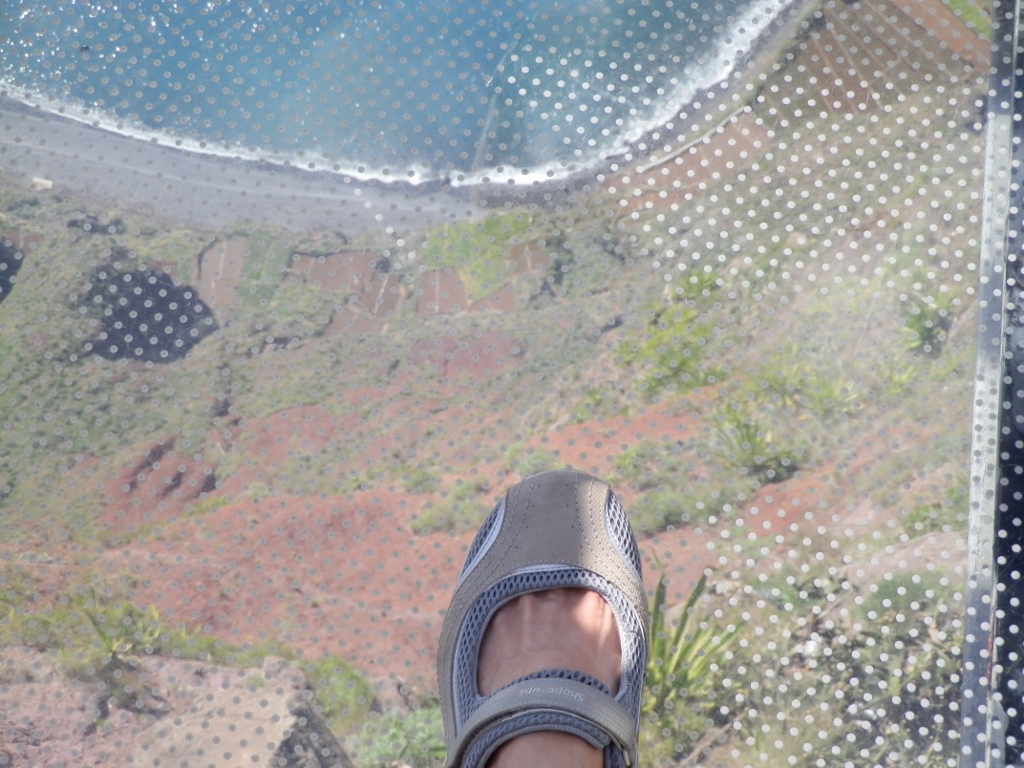 Skywalking
Skywalking
This platform is installed at the altitude of 580 m above sea level and the impression is perhaps even more fantastic when one leans over the fence and looks down. As if you are floating above the sea and the fields beside it.
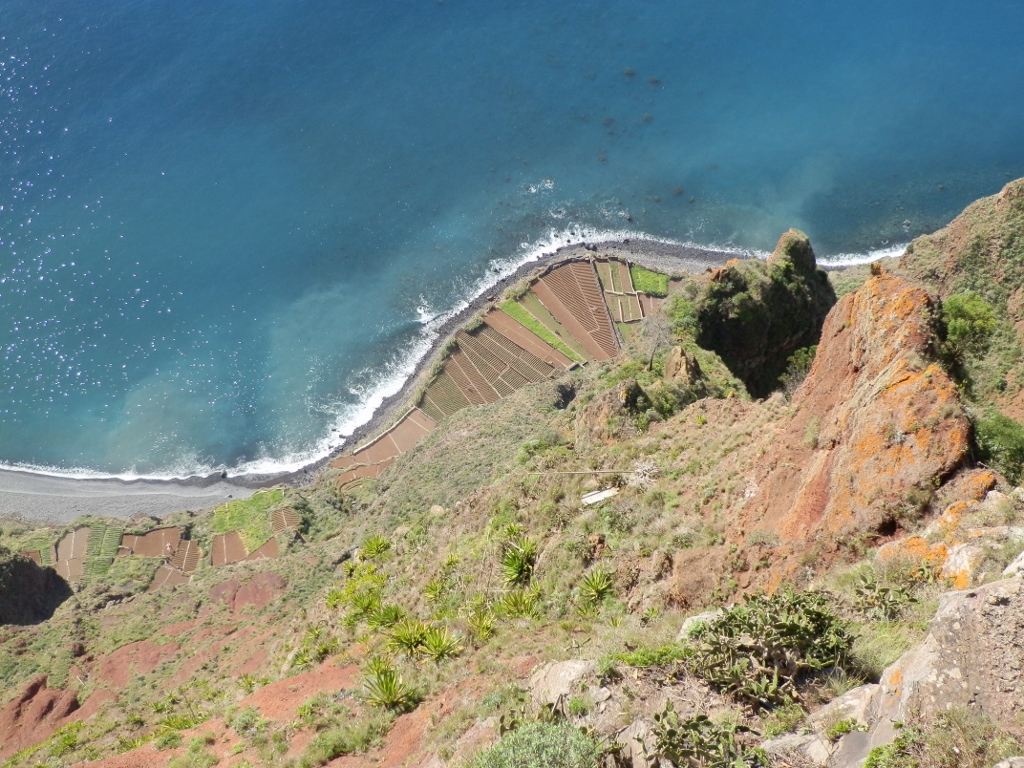 View downwards from the Cabo Girão Skywalk viewpoint
View downwards from the Cabo Girão Skywalk viewpoint
Needless to say, any other way you turn, there is a spectacular view.
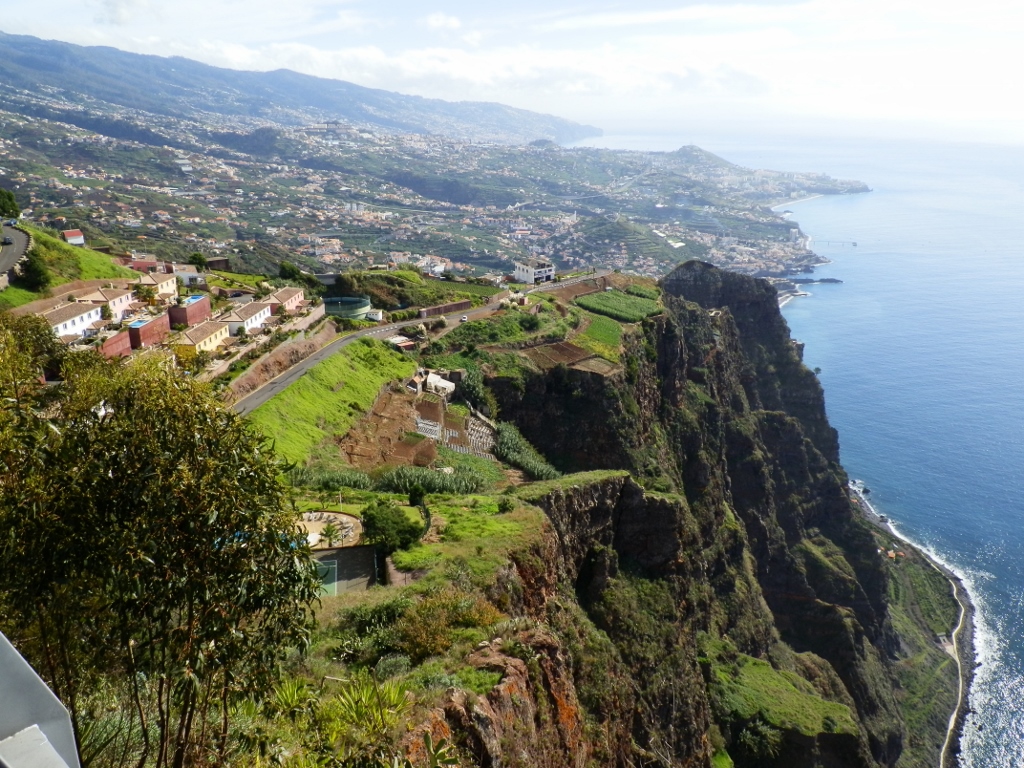 Sideway view from the Cabo Girão Skywalk
Sideway view from the Cabo Girão Skywalk
Joao and I stayed here long enough to enjoy the fantastic views and the stunning weather, while I took photos of that, and then we went back to the car and continued with our tour of Madeira.